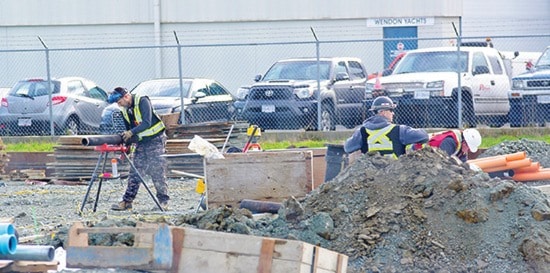Sidney is in on the ground floor of a new regional economic development program, the South Vancouver Island Economic Development Association (SVIEDA).
The organization recently reached its required threshold of a minimum of seven municipal partners. Sooke became the seventh when it voted at the beginning of December to help fund the body. Its mandate is to bringing together municipal governments, business and post-secondary institutions in a unified way to reverse the Capital Region’s slide from fourth in gross domestic product (GDP) growth in 2008 among Canada’s large metropolitan areas to 27th in 2013.
Sidney was an early adopter of the program, following its own creation of a local economic development commission, tasked with implementing the recommendations out of a Mayor’s Task Force on Downtown Revitalization, completed prior to the 2014 civic election.
Mayor Steve Price says Sidney councillors want to see the region grow. Participation, he explained, means the Town has some degree of say in how the region engages with business and other levels of government to broaden the area’s economy.
“This (Association) is looking to engage business startups and expansions that in turn will lead to more well-paying jobs,” Price said.
He added part of the Association’s work will be to diversify the economy and not have it heavily reliant upon tourism or even retail. The members of the Association met late last week and voted to focus their efforts on areas such as agribusiness, ocean technology, aviation and aerospace, advanced manufacturing, clean technology, advanced education and sport and culture.
Dan Dagg, the association’s acting chair, is also board chair of the Greater Victoria Development Agency. That group has been working for years to help bring new business to the region and strengthen its economic base. Dagg said it took recognition of the stagnant growth rate for a new approach to be considered. A workshop held last month for municipal politicians and senior staffers outlined the new strategy.
“There was a buzz within that room. People actually got goose bumps around the spirit of collaboration and goodwill amongst everybody — that’s new,” Dagg said. “This has never happened before where we’ve got such universal support from municipalities, all lined up to do the right thing.”
Among the benefits of working together, he said, is the ability to apply for larger government grants for regional projects, such as those addressing transportation, and a move toward attracting and keeping industries that provide “household-sustaining” jobs for local residents.
Price said the Town’s local economic development commission will focus on the Town and be able to turn to SVIEDA as a resource. He said he wants the local commission to focus on what can be achieved in the short term, acting as a nimble body, responding to the needs of the municipal council.
“It’s going to be a really successful venture,” Price said of both economic development functions.
Collectively, the region has put comparatively little toward economic development — the GVDA receives $80,000 a year. Most engage in the activity off the side of their desks or not at all, so it’s not surprising the region’s growth has slid.
The initial funding model for the new agency sees member municipalities contribute $1 per resident plus .07 per cent of property tax collected, which Dagg estimates at roughly $670,000 per year.
“It’s still not as much money as a lot of other cities are spending, but when you roll in the private sector … it’s a giant leap forward from the $80,000 we’re getting now.”
Dagg said the interim committee members and GVDA staff are working on a five-year economic development strategy, working with industry and education experts and making themselves aware of upcoming project grant application deadlines.
Dagg suggested the goal of the new agency is not to simply help facilitate service industry growth to meet increases in population, but to create an atmosphere where it makes sense to do business in Greater Victoria.
The founders — Metchosin and District of North Saanich are the only ones out of the region’s 13 municipalities to not join SVIEDA — this week issued a call to action to local business leaders to step forward and commit their expertise and knowledge to help advance the strategic priorities of the new organization. The call for candidates to serve on the board will be issued in early January.
— with files from Don Descoteau/Goldstream News Gazette, Black Press
